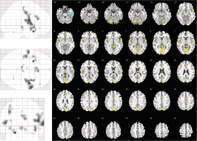- Record: found
- Abstract: found
- Article: found
Central encoding of the strength of intranasal chemosensory trigeminal stimuli in a human experimental pain setting

Read this article at
Abstract
An important measure in pain research is the intensity of nociceptive stimuli and their cortical representation. However, there is evidence of different cerebral representations of nociceptive stimuli, including the fact that cortical areas recruited during processing of intranasal nociceptive chemical stimuli included those outside the traditional trigeminal areas. Therefore, the aim of this study was to investigate the major cerebral representations of stimulus intensity associated with intranasal chemical trigeminal stimulation. Trigeminal stimulation was achieved with carbon dioxide presented to the nasal mucosa. Using a single‐blinded, randomized crossover design, 24 subjects received nociceptive stimuli with two different stimulation paradigms, depending on the just noticeable differences in the stimulus strengths applied. Stimulus‐related brain activations were recorded using functional magnetic resonance imaging with event‐related design. Brain activations increased significantly with increasing stimulus intensity, with the largest cluster at the right Rolandic operculum and a global maximum in a smaller cluster at the left lower frontal orbital lobe. Region of interest analyses additionally supported an activation pattern correlated with the stimulus intensity at the piriform cortex as an area of special interest with the trigeminal input. The results support the piriform cortex, in addition to the secondary somatosensory cortex, as a major area of interest for stimulus strength‐related brain activation in pain models using trigeminal stimuli. This makes both areas a primary objective to be observed in human experimental pain settings where trigeminal input is used to study effects of analgesics.
Abstract
Related collections
Most cited references77
- Record: found
- Abstract: found
- Article: not found
Automated anatomical labeling of activations in SPM using a macroscopic anatomical parcellation of the MNI MRI single-subject brain.
- Record: found
- Abstract: not found
- Article: not found
Silhouettes: A graphical aid to the interpretation and validation of cluster analysis
- Record: found
- Abstract: not found
- Article: not found
